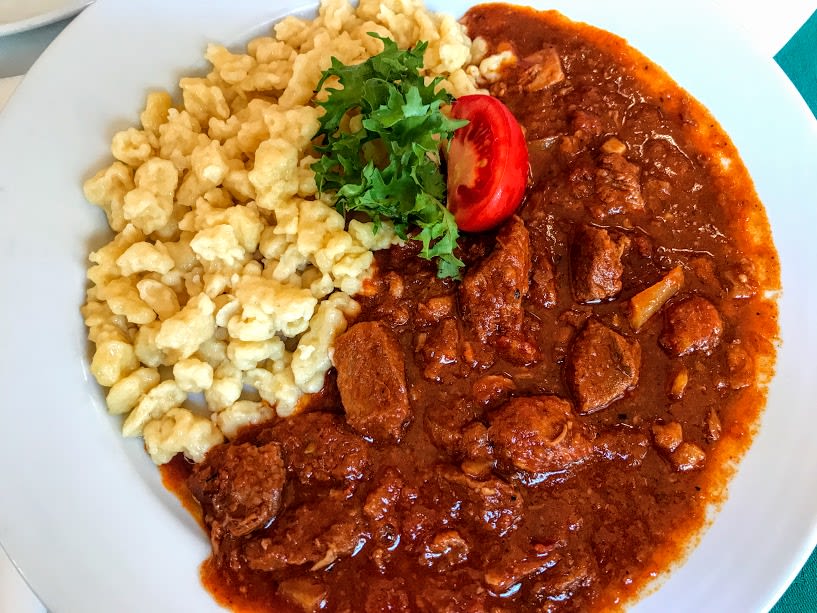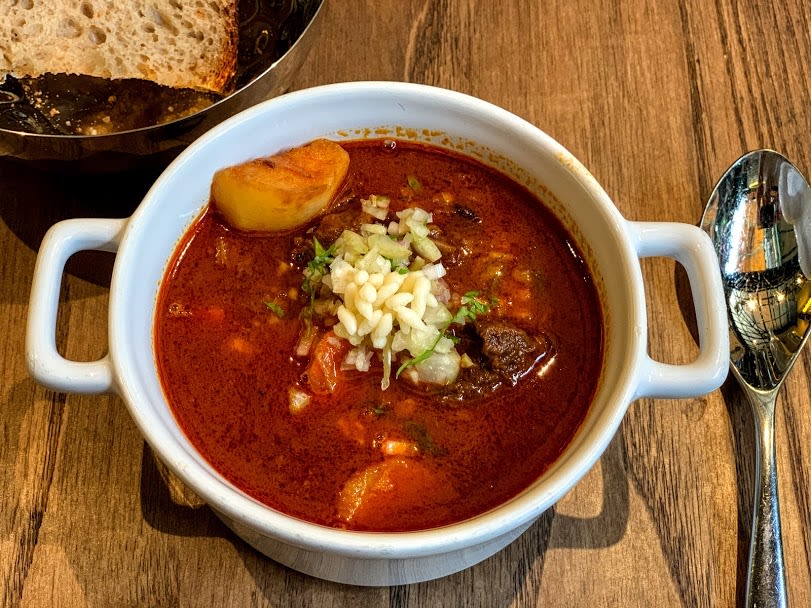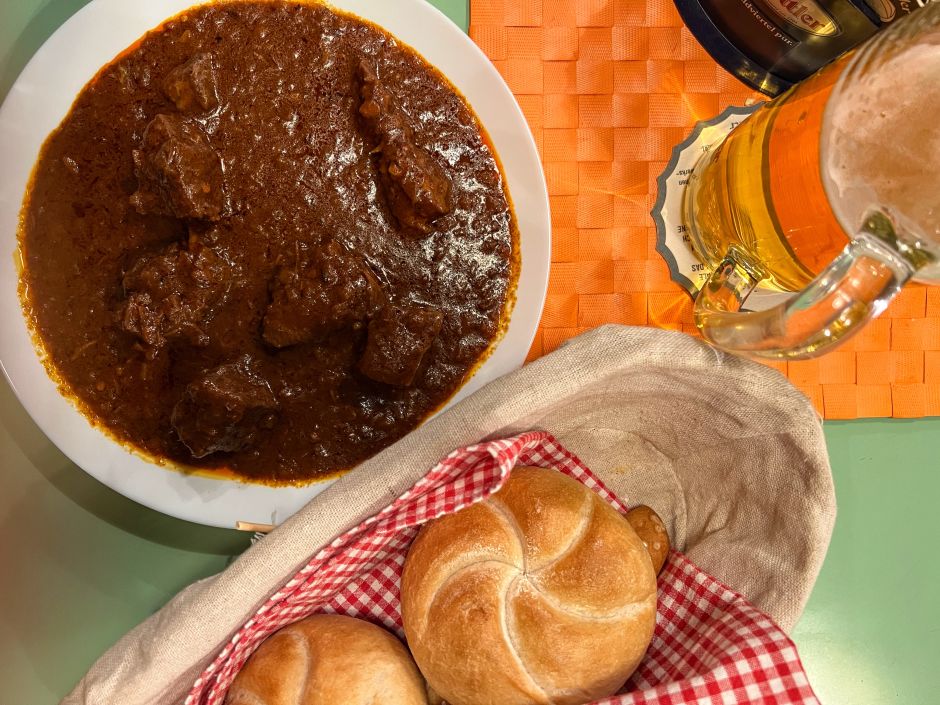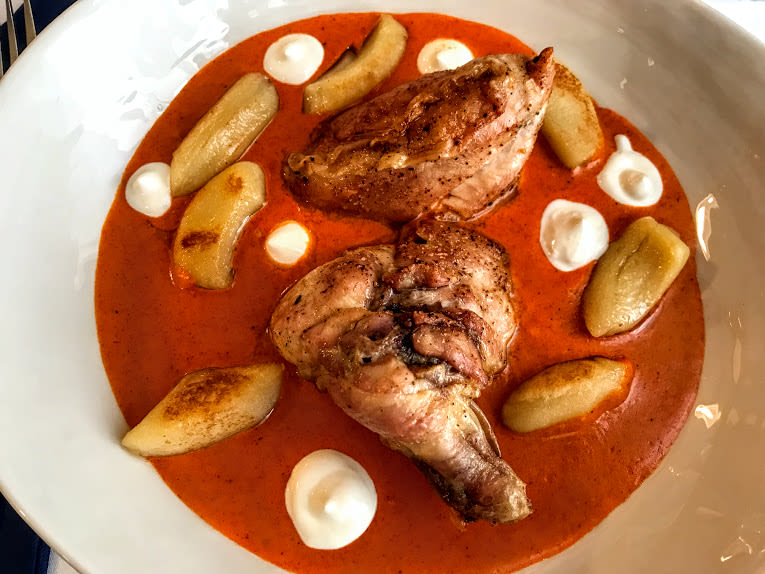Once a lowly dish for herdsmen and peasants, goulash rose to fame thanks to the Habsburg Empire and Hungarian immigration abroad. A recipe follows the end of this article.

No Hungarian food is more well-known than the goulash. What pizza is to Italy and a burger to America, the goulash is to Hungary. This paprika-infused beef stew has even transcended the boundaries of gastronomy: “Goulash Communism” has come to refer to Hungary’s political system within the Eastern Bloc. One may wonder: How did the goulash become so famous?
Apart from wine, Hungary’s main export was cattle between the 16th and 18th centuries; every year, German and northern Italian cities bought more than 100,000 live Hungarian Grey cattle (szürkemarha) for their meat. These hardy animals were raised on the Alföld, large swaths of uninhabited flatland in eastern Hungary, where they spent the whole year out in the pasture grazing. Away from all signs of civilization, the diet of the herdsmen who tended to the animals — the gulyás — consisted, naturally, of beef.
The gulyás would sprinkle szalonna (pork fat) and onions into large cast-iron kettles called bogrács and roast the morsels of beef over fire. Slices of crusty bread helped mop up the juices. It was simple, hearty, rustic fare. They dried leftovers in the sun and nibbled on over the next few days. Over time, peasants from the nearby Alföld villages adopted the dish, calling it “goulash meat” or “pörkölt,” which means roasted. The choice of meat depended on local conditions: some made it with poultry, others with pork or mutton.

A new spice appeared in Hungary in the 18th century that soon became the defining feature of goulash: the paprika. Christopher Columbus brought the chili peppers — locally known as paprika — to Europe from the Americas, but it took a while for it to spread across the continent.
Hungarian peasants became especially fond of the stuff as it was cheaper than imported black peppercorns and gave an appealing ruby color and a hint of pungency to dishes. And so the modern goulash was born, along with yet another name for it: paprikash. “Not a Sunday, if no paprikash,” an old saying from the town of Szentes shows the prominent role it came to play in people’s weekly diet. (The first Hungarian cookbook to include paprika in the goulash came out only in 1826.)
It was around the same time that political events threw this provincial dish in the limelight. When enlightened Habsburg Emperor, Joseph II, tried to more closely integrate Hungary into the Monarchy in the 1780s and curb the privileges of the nobility, they responded by championing Hungarian traditions: They paraded the goulash as an example of the distinct local culture.
“Ironically, few Hungarian noblemen must have actually tasted this rustic, countryside dish,” said Eszter Kisbán, a Professor Emerita at Pécs University and the leading ethnographer specialized in Hungary’s food culture. With the death of Joseph II, the threat was averted, but the “national dish” was there to stay.
The goulash moved further into the mainstream when the educated elites turned to folk culture for inspiration during the so-called Romantic movement of the early 19th century. What was previously a lowly dish of cow herders and the peasantry gradually conquered the dining tables of city residents and even the aristocracy by the mid-19th century. Budapest restaurants, and also the National Casino, the most exclusive social club for the upper crust, featured goulash on their menus.

Abroad, goulash owes its fame in large part to the influence of restaurants in Vienna, the Habsburg capital and one of the biggest cities in Europe then. Savvy restaurateurs served it under the exotic-sounding “Hungarian goulash meat” to grab the attention of curious patrons.
“Its spice-level and striking red color made it stand out from other dishes,” said Kisbán. “Austrian cookbooks actually cautioned readers about the goulash’s paprika-induced heat. Paprika did exist in Austria too but they mostly used black peppercorns for seasoning. Plus, it was a good story to tell.” Today, still, the goulash is a staple in every traditional Viennese restaurant.

Outside Europe, Hungarian immigrants spread the word about goulash. For example, by the 1940s, more than 100,000 Magyars lived in a concentrated area on New York City’s Upper East Side, where a section became known as “Goulash Avenue.” It was lined with Hungarian restaurants and specialty stores, including the legendary Paprika Weiss. Although less fashionable than a couple of decades ago, goulash is still favored in America — it’s among the most popular of the 10,000 featured recipes on the New York Times Cooking website.
Goulash terminologies can be confusing. Abroad, goulash has retained its original meaning — a paprika-strewn beef stew usually served with egg dumplings (galuska or nokedli) on the side. A paprikash is essentially the same thing except it’s made with chicken or veal and finished with sour cream. Here’s the tricky part: In Hungary, the original goulash is called pörkölt, and goulash actually refers to a soupy beef stew with potatoes. But the point is that these are nearly identical stew dishes made from the same foundation — lard, onions, paprika — that chefs and home cooks call the “goulash base.”

Over the past century, few visitors have left Hungary without trying a bowl of goulash. Almost all restaurants serve it, especially those in the touristed areas of Budapest. The quality is a bit inconsistent, but some places are worth visiting specifically for their goulash. The spice level has been tamed since the days of yore — the paprika flavor isn’t so much hot as it is sweet and sharp.
In case a trip to Hungary isn't feasible for you currently, you can always make it at home. Below, I included a recipe for how I make a classic goulash soup. Don’t worry, it requires no cast-iron kettle, nor an open fire.
My content is free and independent. If you've enjoyed this article, please consider supporting me by making a one-time payment (PayPal, Venmo).
Goulash soup (6-7 servings; 3 hours cooking time):

For the soup
450 grams (1 pound) beef chuck or shank, cut into 2 cm (¾ inch) cubes
2 tablespoons lard (if you don’t have any, you can render fatback or pork belly fat or simply use vegetable oil)
2 ½ tablespoons Hungarian sweet paprika
1 teaspoon ground caraway seeds
2 onions, peeled and minced
4 cloves garlic, peeled and minced
3 teaspoons salt (more to taste)
2 pinches freshly ground pepper
4 medium potatoes (600 grams; 1 ⅓ pounds), cut into 2 cm (¾ inch) chunks
2 medium carrots, peeled and sliced thin
1 ripe medium tomato, peeled and cut into very small pieces (or puréed into smooth paste using an immersion blender)
1 Hungarian wax pepper or yellow bell pepper, cored, seeded, and cut into very small pieces (or puréed into smooth paste using an immersion blender)
½ celery root, peeled and halved
2 parsnips, peeled and quartered
2 liters (2 quarts) water or stock
Optional: ½ cup dry white wine (alcohol will evaporate)
1 bunch fresh parsley, chopped
Slices of crusty bread
Optional: hot paprika paste for the side
For the dumplings (csipetke)
1 egg
80 grams (⅔ cup) all-purpose flour
Pinch of salt
Step 1: Heat lard (or oil) in a large pot or Dutch oven over medium-high, then add minced onion and sauté until translucent, about 6-8 minutes.
Step 2: Add meat and sear until it’s lightly browned, about 5-6 minutes.
Step 3: Reduce heat to medium-low and add paprika, ground caraway seeds, salt, black pepper, celery root, parsnip, carrots, minced garlic, and the small bits of tomato and yellow pepper. Add 2 liters (2 quarts) water or stock (and wine, if you’re using it) to cover them. Place lid on pot and let it cook at a low simmer until beef is very tender, about 2 ½ hours.
Step 4: In the meantime, prepare the dumplings (csipetke) by mixing egg, flour, and salt. Knead them into a firm dough (add more flour if needed), then let it rest.
Step 5: When beef is ready, add potato chunks and cook on a brisk simmer until potatoes are soft but not mushy, about 20 minutes.
Step 6: In the meantime, add dumplings (csipetke) by pinching small pieces off the dough and tossing them into the soup. Yes, it’s a little tedious. Dumplings are ready when they rise to the top, about 2-3 minutes.
Step 7: Mix in chopped parsley (retain a bit for garnish). Taste for salt and pepper and add more if needed. Discard the celery and parsnip pieces from the soup as they've released their flavor. Serve the goulash in soup bowls with a drizzle of parsley on top and slices of crusty bread and hot paprika paste on the side.
The article above is mainly based on the research findings of Eszter Kisbán, Professor Emerita at the University of Pécs and the leading ethnographer specialized in Hungary's food culture. Here, you can read my interview with her.